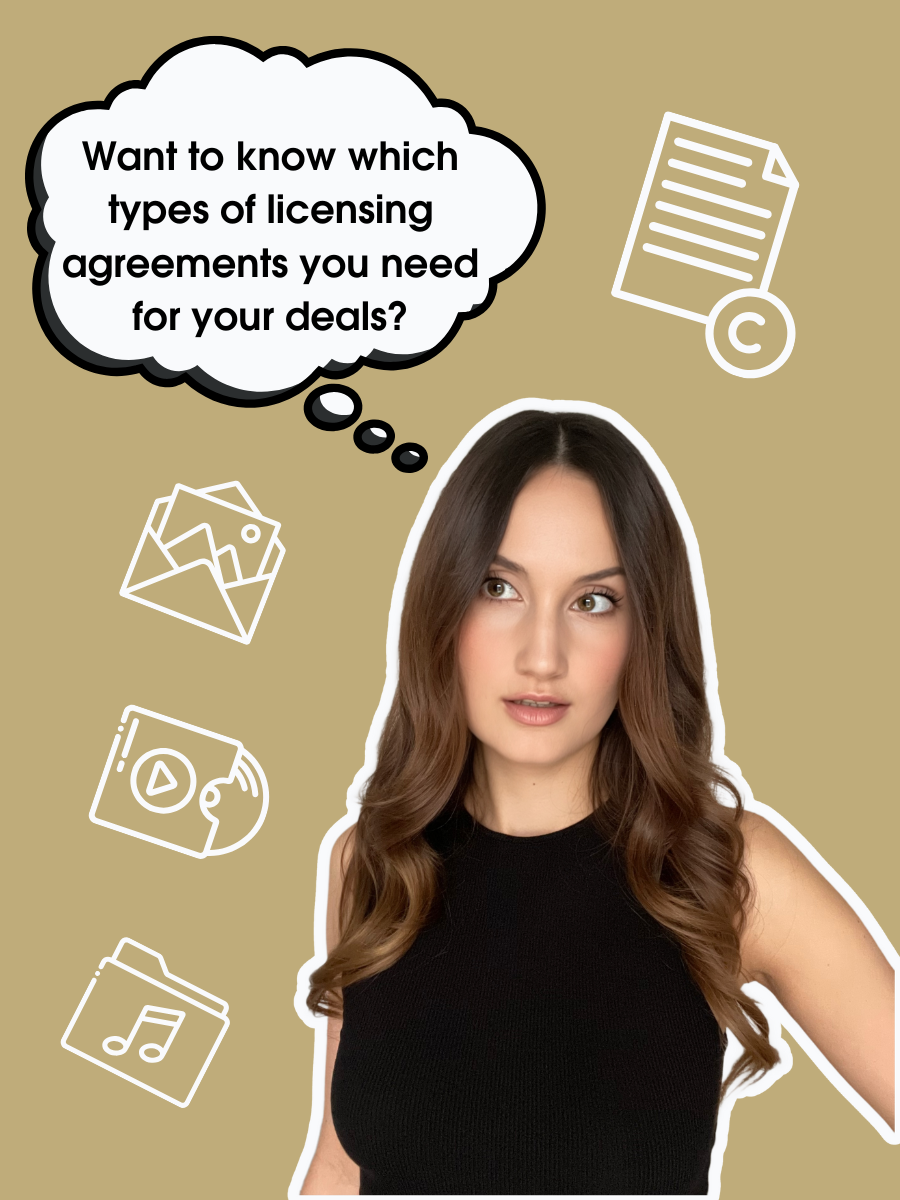3 Key Types of Licensing Agreements to Protect Your Work (or Use Someone Else’s) Without Legal Headaches
Whether you’re protecting your own work or using someone else’s, the right types of licensing agreements can make your deal, but the wrong ones can cause major issues.
Get it wrong, and you could lose control of your rights, face a takedown request, or even end up paying unexpected fees.
The good news? Once you understand the 3 key types of licensing agreements, you can choose the right one for any situation — and avoid costly mistakes.
In this guide, you’ll learn exactly what the different types of licensing in business, when to use it, and see practical licensing agreement examples you can apply right away.
You’ll also see how having clear, plain-English contracts for all types of licensing agreements (like the ones in my Licensing Agreements Bundle) ensures both sides know exactly what’s allowed — and what’s not.
This post is all about the 3 key types of licensing agreements to protect your work or legally use someone else’s, without the legal headaches.
Key Types of Licensing Agreements
Need Licensing Contracts for All 3 Types of Licensing in Business?
My Licensing Agreement Bundle includes:
1 template for when you’re the licensor (the one granting a license), which protects your work & sets usage limits
1 template for when you’re the licensee (the one receiving a license), which protects you from overstepping & takedowns
Each of these licensing agreements is fully customizable with the option to grant or receive an exclusive, sole, or non-exclusive license — so you have all 3 types of licensing agreements in ONE bundle!
Get the Licensing Agreement Bundle here → and lock in the right terms for every deal.
What are the 3 types of licensing agreements?
There are 3 types of licensing agreements. What are the 3 types of licensing agreements? These are the licensing agreements you must know:
Exclusive license agreement
Sole licensing agreement
Non-exclusive licensing agreement
Let me explain what each of these types of licenses is in more detail.
Exclusive License Agreement
An exclusive licensing agreement is the first of the 3 types of licensing agreements, which gives the licensee the sole right to use the specific intellectual property (IP) rights described in the agreement.
No one else — not even the licensor — can use those same rights during the license term, unless the agreement specifically carves out exceptions.
This is where many people get tripped up:
Myth: “I’m still the owner, so I can use it too.”
Reality: Ownership and usage rights are different. You can remain the owner but still give up your right to use the IP during the license term.
Thus, an exclusive license agreement can be a great deal if you’re the one getting the license. You’ll have complete control over the agreed usage without worrying about competitors or even the licensor using the same IP.
But if you’re the one granting the license, an exclusive license agreement is usually not in your best interest compared to the other types of licensing agreements. You’d be giving up your own right to use your work, which can severely limit your creative or business options — often without enough extra compensation to make it worth it.
That’s why:
My Licensor-Friendly Licensing Agreement Template only includes sole and non-exclusive license options — so you can license your work while still using it yourself.
My Licensee-Friendly Licensing Agreement Template includes all 3 types of licensing agreements (the exclusive, sole, and non-exclusive license options) — giving you full flexibility when you’re securing rights from someone else.
Pro Tip: If you’re granting rights, think carefully before agreeing to exclusivity — and if you’re receiving rights, make sure the agreement clearly defines exactly what “exclusive” covers, for how long, and in which territories. My templates make it easy to set those terms without legal guesswork.
Sole Licensing Agreement
A sole licensing agreement means both the licensor and the licensee can use the specified IP rights — but no one else can.
The licensor keeps the ability to use the work themselves while still granting the licensee valuable exclusivity against third parties.
This arrangement is often the best of all three types of licensing agreements when you’re granting a license:
You can continue using your work for your own purposes.
The licensee still benefits from knowing their competitors won’t have access to the same IP.
If you’re receiving a sole license, you’ll have stronger protection than with a non-exclusive license, but you’ll need to accept that the licensor can still use the work too.
That’s why:
My Licensor-Friendly Licensing Contract Template includes sole license and non-exclusive license options — so you keep using your work while offering valuable rights to the other party.
My Licensee-Friendly Licensing Contract Template also includes the sole license option, so you can secure exclusivity against competitors without paying for full exclusivity from the licensor.
Pro Tip: When using a sole license, be specific about what “use” means for each party. My templates give you ready-to-customize clauses so both sides know exactly where, how, and for how long they can use the licensed work.
Non-Exclusive License Agreement
A non-exclusive licensing agreement allows the licensee to use the specified IP rights — but so can the licensor and anyone else the licensor chooses to license to.
This one of the 3 types of licensing agreements is the most flexible for the licensor because it keeps every option open:
You can license the same work to multiple clients or partners.
You can keep using it yourself without restriction.
If you’re granting a license, a non-exclusive license agreement will be the best option of all three types of licensing agreements for things like:
Selling digital products (eBooks, courses, stock photos)
Allowing multiple brands or clients to use the same creative work
Licensing widely for maximum reach and income potential
If you’re receiving a non-exclusive license, you’ll usually pay less than for exclusive or sole rights — but you won’t have exclusivity against others using the same work.
That’s why:
My Licensor-Friendly Licensing Agreement Template includes the non-exclusive license option, so you can scale your licensing income without giving up your own rights.
My Licensee-Friendly Licensing Agreement Template also includes the non-exclusive license option for situations where exclusivity isn’t necessary and cost savings are the priority.
Pro Tip: With non-exclusive licenses, clearly define the permitted uses so there’s no confusion about what’s allowed. My templates include customizable “purpose” and “location” clauses so you can set precise usage limits for any deal.
The ULTIMATE Templates for All Types of Licensing in International Business
Understanding all 3 types of licensing agreements is one thing — having airtight licensing contracts for them is another.
My Licensing Agreement Bundle gives you both sides of the deal:
Licensor-Friendly Licensing Agreement Template → Includes sole and non-exclusive license options so you can keep using your work while licensing it out.
Licensee-Friendly Licensing Agreement Template → Includes exclusive, sole, and non-exclusive options so you can secure exactly the rights you need from someone else.
Fully customizable so you can set the license term, purpose, location, and any exceptions in plain English.
✅ Cross-border ready with wording designed for international deals, so your rights and usage terms are clear no matter where the other party is based.
📄 Stop guessing what to include — get both templates and lock in the right terms for any deal.
Get the Licensing Agreement Bundle →
Licensing Agreement Examples to Help You Choose the Right License
Now you know what the differences are between the 3 types of licensing, but now you need to figure out which one is the right type for your specific situation.
Here are some common licensing agreement examples for different types of licensing in business — and how the right type of license makes all the difference:
1. Brand sponsorship deal
A brand pays you to post sponsored content on your platform. But what happens to that content after it’s posted? Here are the types of licensing agreements I’d recommend:
If you’re the creator → My Creator-Friendly Sponsorship Agreement protects you by keeping ownership in your hands. The brand only gets a sole license — meaning they can use the content, but you can still use it too. You’re never giving away exclusivity or full ownership.
If you’re the brand → My Brand-Friendly Sponsorship Agreement works the other way around. It lets you secure either (a) full ownership of the sponsored content, or (b) a perpetual, worldwide, royalty-free sole license with the right to adapt, edit, and promote it however you want. That way, you don’t risk losing access to the content later.
Bottom line: If you’re creating, you protect your work. If you’re the brand, you protect your investment. My Brand Sponsorship Bundle gives you both options, so you’re covered no matter which side of the deal you’re on.
2. User-generated content (UGC)
A brand hires a creator to produce content (e.g., a video or photo set) for the brand to use on its own platforms.
If you’re the creator → My Creator-Friendly UGC Agreement keeps ownership of the Deliverables with you. The brand only gets a license — and you choose whether it’s sole, exclusive, or non-exclusive, how long it lasts, where it can be used, and whether they can run ads with it. Even if you grant an exclusive license, you still retain the right to showcase your work in your portfolio. If the brand wants additional rights (like editing or full IP transfer), those must be separately agreed (and paid for). This ensures you never give away unlimited rights for a flat fee.
If you’re the brand → My Brand-Friendly UGC Agreement flips the balance in your favor. By default, it vests full ownership of the Deliverables in you (assignment of IP), or you can opt for a perpetual, worldwide sole or exclusive license with full editing, reproduction, and ad rights. This way, you’re not stuck asking for extra permissions later.
Bottom line: UGC deals are where brands often push for “all rights included” while creators risk undervaluing their work. With my UGC Contract Bundle, creators keep control (and portfolio rights), while brands secure the usage they need without hidden limits.
3. Licensing existing content to a brand
A brand asks to use content you’ve already posted (like a recipe video or lifestyle photo).
As the licensor (you, the creator) → You’ll usually grant a non-exclusive license so you can keep using and monetizing your work elsewhere.
My Licensor-Friendly Licensing Agreement Template is built for exactly this — protecting your rights while clearly defining what the brand can (and can’t) do.
As the licensee (the brand) → You’ll want the contract to confirm whether the license is exclusive or non-exclusive, and how long it lasts.
My Licensee-Friendly Licensing Agreement Template handles this for you, making sure you get the clarity you need before investing in someone else’s content.
4. Licensing existing content to another creator
Another creator wants to feature your photo, video, or design on their platform.
You can grant them a non-exclusive license so you still keep full control and can license the same work elsewhere.
You might even exchange it for credit or a cross-license to their content.
My Licensor-Friendly Licensing Agreement Template makes this easy by covering all the terms for licensing out your existing content without accidentally giving away more than you intended.
5. Using existing content from another creator
You want to use someone else’s photo, video, or design on your platform.
You’ll need a license (exclusive, sole, or non-exclusive) that clearly sets the purpose, term, and location of use — otherwise you risk takedown notices.
Not sure how to ask? Start with my free email template: 7+ (Legal) Essentials You Need in Your Copyright Permission Request Email (+ Free Email Template).
Then, seal the deal with my Licensee-Friendly Licensing Agreement Template, designed specifically for when you’re licensing existing content from someone else.
6. Guesting on another creator’s podcast or YouTube channel
When you’re a guest on someone else’s platform, you’re automatically granting them a license to use your likeness, voice, and content.
Without clear terms, they could edit your words, run ads with your appearance, or use the recording in ways you never agreed to.
For podcasts → My guest-friendly Podcast Guest Agreement sets clear boundaries on how your interview can be used, making sure you’re not misrepresented and that you retain control over your personal brand.
For YouTube → My guest-friendly YouTube Collaboration Agreement protects you when appearing on someone else’s channel (or bringing them onto yours). It clarifies the entire process from recording to licensing and editing rights to repurposing.
7. Having a guest on your platform
When you invite a guest onto your podcast or YouTube channel, you’ll want a clear license from them so you can legally use, edit, and promote the recording. Without one, they could later demand takedowns or limit how you use the content you created together.
For podcasts → My podcaster-friendly Podcast Guest Agreement makes sure your guest grants you the rights you need — from publishing to editing to promotion — while protecting you from later disputes.
For YouTube → My YouTuber-friendly YouTube Collaboration Agreement covers collabs and guest appearances, spelling out who owns the content, how it can be repurposed, and whether both sides can use it for promotion.
The ULTIMATE Licensing Agreements for Licensing Your Work
At the end of the day, licensing is where the real risks — and opportunities — lie. Whether you’re licensing out your own work or using someone else’s, the difference between a smooth deal and a legal headache is having the right agreement in place.
That’s exactly why I created my License Agreement Bundle. It gives you:
A Licensor-Friendly License Agreement to protect your work when you’re the one granting rights.
A Licensee-Friendly License Agreement to protect you when you’re requesting rights to someone else’s work.
Both are fully customizable, work across borders, and cover all three licensing types (exclusive, sole, and non-exclusive) — so you’re never stuck with vague terms or one-sided deals.
Get the License Agreement Bundle here and protect your content, your income, and your collaborations the right way from day one.
This post was all about the differentnt types of licensing agreements you must know about to choose the best license for your deal.
Want to learn more about the 3 types of licensing? Read these blog posts next:





